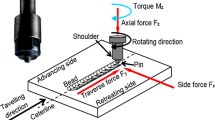Abstract
Abrasive flow finishing (AFF) is one of the advanced finishing processes and rotational AFF (R-AFF) is one of its variant wherein workpiece is provided with additional rotational motion. Polymer rheological abrasive medium used in R-AFF process perform an important role in reducing the workpiece surface roughness. In the present paper, different types of in-house medium are prepared by varying composition of the silicon-based polymer, rheological additives, and abrasive particles. Later rheological characterization (static and dynamic) medium is carried out to understand the flow and deformation properties. Fourier transform infrared spectroscopic analysis of the medium is performed to find the new functional groups in the medium. To study the effect of various medium constituents on its rheological properties and finishing abilities, experiments are designed as per central composite rotatable design and analyzed using response surface methodology. The rheological study shows that, as the wt.% of silicon polymer and abrasive particles increases, maximum shear stress as well as complex viscosity also increases. Increase in wt.% of plasticizer and abrasive particles increases medium % viscous component. Viscous properties are dominant in soft silicone based medium and ΔRa increases with an increase in wt.% of silicone polymer. ANOVA analysis shows that wt.% of abrasive particles has highest effect on ΔRa and followed by wt.% of plasticizer. Better surface finish is achieved when 43.75% of silicone polymer, 36% SiC, 5% plasticizer, and remaining rheological additives-based medium are used. Among three workpiece materials, the best surface roughness is achieved on Al alloy/SiC (10%) metal matrix composite.
Similar content being viewed by others
References
Rhoades LJ (1989) Abrasive flow machining. Manuf Eng:75–78
Venkatesh G, Sharma AK (2014) Finishing of bevel gears using abrasive flow machining. Procedings Eng 97:320–328
Reddy MK, Sharma AK, Kumar P (2008) Some aspects of centrifugal force assisted abrasive flow machining of 2014 Al alloy. Proc Inst Mech Eng B J Eng Manuf 222(7):773–783
Walia RS, Shan HS, Kumar PK (2006) Finite element analysis of media used in the centrifugal force assisted abrasive flow machining process. Proc Inst Mech Eng B J Eng Manuf 220(11):1775–1785
Walia RS, Shan HS, Kumar P (2008) Morphology and integrity of surfaces finished by centrifugal force assisted abrasive flow machining. Int J Adv Manuf Technol 39(11):1171–1179
Sankar MR, Jain VK, Ramkumar J (2010) Rotational abrasive flow finishing (R-AFF) process and its effects on finished surface topography. Int J Mach Tools Manuf 50(7):637–650
Sankar MR, Jain VK, Ramkumar J (2009) Experimental investigations into rotating workpiece abrasive flow finishing. Wear 267(1–4):43–51
Hull JB, Sullivan DO’, Fletcher AJ, Trengove SA, Mackie J (1992) Rheology of carrier media used in abrasive flow machining. Key Eng Mater 72-24:617–626
Davies PJ, Fletcher AJ (1995) The assessment of the rheological characteristics of various polyborosiloxane /grit mixtures as utilized in the abrasive flow machining. Proc Inst Mech Eng 209:409–418
Fletcher AJ, Fioravanti A (1996) Polishing and honing processes: an investigation of the thermal properties of mixtures of polyborosiloxane and silicon carbide abrasive. Proc Inst Mech Eng 210:255–266
Perry KE (1975) Abrasive composition containing a gel and a boron-dialkyl silicon-oxygen polymer, United States Patent, 3,909,217
Tzeng HJ, Yan BH, Hsu RT, Lin YC (2007) Self-modulating abrasive medium and its application to abrasive flow machining for finishing micro channel surfaces. Int J Adv Manuf Technol 32(11):1163–1169
Sankar MR, Jain VK, Ramkumar J, Joshi YM (2011) Rheological characterization of styrene-butadiene based medium and its finishing performance using rotational abrasive flow finishing process. Int J Mach Tools Manuf 51(12):947–957
Kavithaa TS, Balashanmugam N (2016) Nanometric surface finishing of typical industrial components by abrasive flow finishing. Int J Adv Manuf Technol 85(9):2189–2196
Fu Y, Wang X, Gao H, Wei H, Li S (2016) Blade surface uniformity of blisk finished by abrasive flow machining. Int J Adv Manuf Technol 84(5):1725–1735
Uhlmann E, Mihotovic V, Coenen A (2009) Modeling the abrasive flow machining process on advanced ceramic materials. Int J Mater Process Technol 209(20):6062–6066
Jain VK, Rangnatha C, Muralidhar K (2007) Evaluation of rheological properties of medium for AFM process. Mach Sci Technol 5(2):151–170
Sankar MR, Ramkumar J, Jain VK (2009) Experimental investigation and mechanism of material removal in nano finishing of MMCs using abrasive flow finishing (AFF) process. Wear 266(7–8):688–698
Mcvicker NW and Mcvicker JS Plastic modeling composition of a soft pliable working consistency, United States Patent No. 3167440, January 26, 1965
Sankar MR, Jain VK, Ramkumar J, Joshi YM (2012) Dependence of R−AFF process on rheological characteristics of soft styrene based organic polymer abrasive medium. J Manufact Technol Res 4(1/2):89–104
Kar KK, Ravikumar NL, Tailor PB, Ramkumar J, Sathiyamoorthy D (2009) Performance evaluation and rheological characterization of newly developed butyl rubber based media for abrasive flow machining process. J Mater Process Technol 209(4):2212–2221
Kar KK, Ravikumar NL, Tailor PB, Ramkumar J, Sathiyamoorthy D (2009) Preferential media for abrasive flow machining. J Manuf Sci Eng 131(1):011009
Acknowledgements
The authors are thankful for the financial support provided by Board of Research in Nuclear Sciences (Project Number: ME/P/MRS/02), Department of Science and Technology for their Technology Systems Development Programme (DST/TSG/AMT/2015/619), Defense Research Development & Development Laboratory (CARS Project). Authors are thankful for the organizers of the AIMTDR-2016 conference for submitting the extended version of the conference paper in special issue of IJAMT.
Author information
Authors and Affiliations
Corresponding author
Rights and permissions
About this article
Cite this article
Sankar, M.R., Jain, V.K., Ramkumar, J. et al. Medium rheological characterization and performance study during rotational abrasive flow finishing (R-AFF) of Al alloy and Al alloy/SiC MMCs. Int J Adv Manuf Technol 100, 1149–1163 (2019). https://doi.org/10.1007/s00170-018-2244-y
Received:
Accepted:
Published:
Issue Date:
DOI: https://doi.org/10.1007/s00170-018-2244-y




